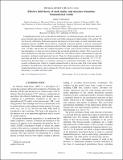| dc.contributor.author | Hertzberg, Mark Peter | |
| dc.date.accessioned | 2014-06-12T18:53:59Z | |
| dc.date.available | 2014-06-12T18:53:59Z | |
| dc.date.issued | 2014-02 | |
| dc.date.submitted | 2013-03 | |
| dc.identifier.issn | 1550-7998 | |
| dc.identifier.issn | 1550-2368 | |
| dc.identifier.uri | http://hdl.handle.net/1721.1/87754 | |
| dc.description.abstract | Complimenting recent work on the effective field theory of cosmological large scale structures, here we present detailed approximate analytical results and further pedagogical understanding of the method. We start from the collisionless Boltzmann equation and integrate out short modes of a dark matter/dark energy dominated universe (ΛCDM) whose matter is comprised of massive particles as used in cosmological simulations. This establishes a long distance effective fluid, valid for length scales larger than the nonlinear scale ∼10 Mpc, and provides the complete description of large scale structure formation. Extracting the time dependence, we derive recursion relations that encode the perturbative solution. This is exact for the matter dominated era and quite accurate in ΛCDM also. The effective fluid is characterized by physical parameters, including sound speed and viscosity. These two fluid parameters play a degenerate role with each other and lead to a relative correction from standard perturbation theory of the form ∼10[superscript −6]c[superscript 2]k[superscript 2]/H[superscript 2]. Starting from the linear theory, we calculate corrections to cosmological observables, such as the baryon-acoustic-oscillation peak, which we compute semianalytically at one-loop order. Due to the nonzero fluid parameters, the predictions of the effective field theory agree with observation much more accurately than standard perturbation theory and we explain why. We also discuss corrections from treating dark matter as interacting or wavelike and other issues. | en_US |
| dc.description.sponsorship | Stanford Institute for Theoretical Physics | en_US |
| dc.description.sponsorship | Kavli Institute for Theoretical Physics | en_US |
| dc.description.sponsorship | National Science Foundation (U.S.) (Grant PHY-0756174) | en_US |
| dc.description.sponsorship | Kavli Institute for Theoretical Physics (Fellowship) | en_US |
| dc.language.iso | en_US | |
| dc.publisher | American Physical Society | en_US |
| dc.relation.isversionof | http://dx.doi.org/10.1103/PhysRevD.89.043521 | en_US |
| dc.rights | Article is made available in accordance with the publisher's policy and may be subject to US copyright law. Please refer to the publisher's site for terms of use. | en_US |
| dc.source | American Physical Society | en_US |
| dc.title | Effective field theory of dark matter and structure formation: Semianalytical results | en_US |
| dc.type | Article | en_US |
| dc.identifier.citation | Hertzberg, Mark P. “Effective Field Theory of Dark Matter and Structure Formation: Semianalytical Results.” Phys. Rev. D 89, no. 4 (February 2014). © 2014 American Physical Society | en_US |
| dc.contributor.department | Massachusetts Institute of Technology. Center for Theoretical Physics | en_US |
| dc.contributor.department | Massachusetts Institute of Technology. Department of Physics | en_US |
| dc.contributor.mitauthor | Hertzberg, Mark Peter | en_US |
| dc.relation.journal | Physical Review D | en_US |
| dc.eprint.version | Final published version | en_US |
| dc.type.uri | http://purl.org/eprint/type/JournalArticle | en_US |
| eprint.status | http://purl.org/eprint/status/PeerReviewed | en_US |
| dspace.orderedauthors | Hertzberg, Mark P. | en_US |
| dc.identifier.orcid | https://orcid.org/0000-0002-3850-3688 | |
| mit.license | PUBLISHER_POLICY | en_US |
| mit.metadata.status | Complete | |
